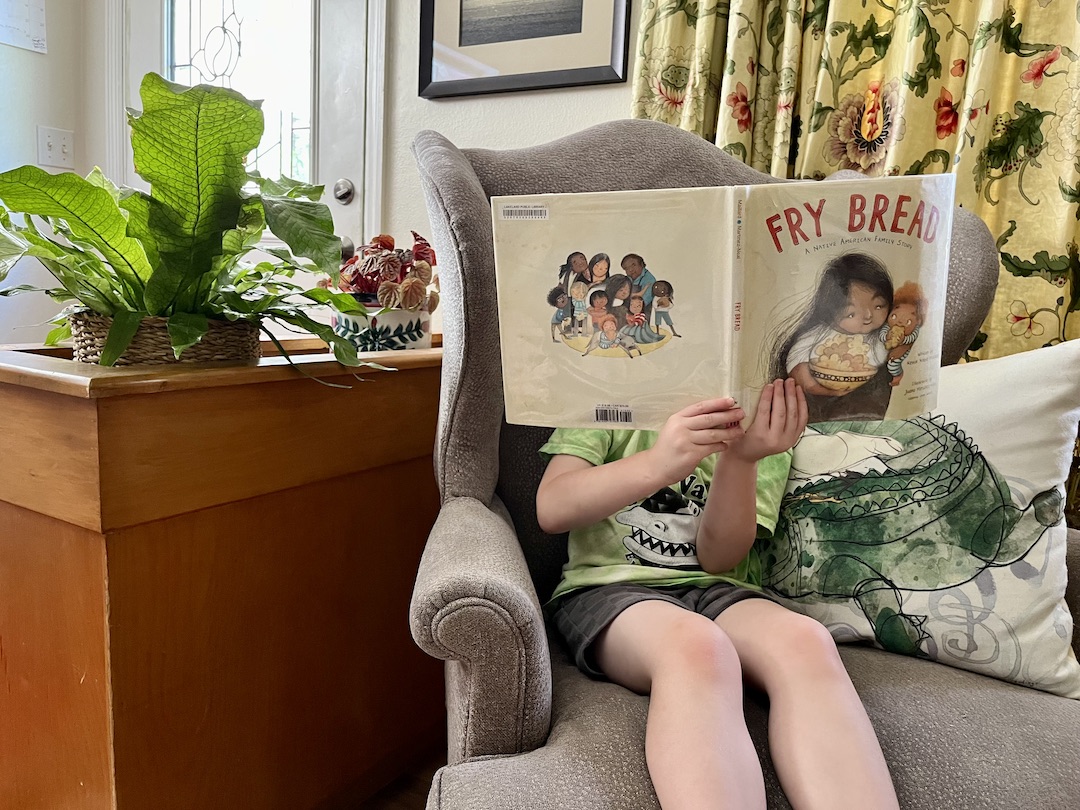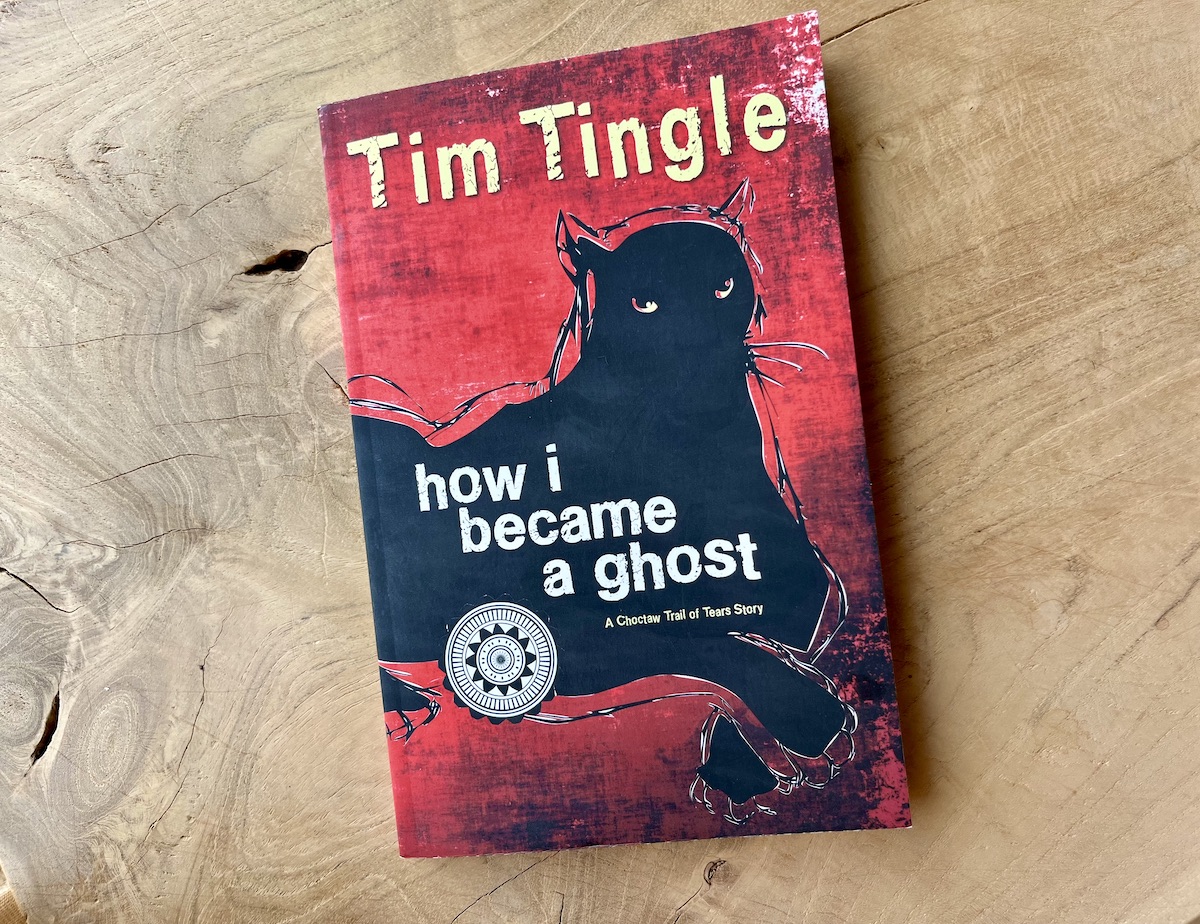
Hope and Healing in Traci Sorell’s Excellent Book: Powwow Day
Welcome back to the second part of our first week of Summer Book Club! This week, we focus on selections for our youngest readers. Last Friday, we shared Fry Bread: A Native American Family Story by Kevin Nobel Maillard. Today, we are looking at Traci Sorell’s Powwow Day. Powwow Day is a hopeful and uplifting look at the power of family, community, and healing.
As always, we encourage you to seek out and uplift the Native authors, artists, and communities around you. Share their voices and perspectives with your family and friends, and be part of a more resilient and understanding world.
Powwow Day by Traci Sorell
Gorgeously illustrated by Madelyn Goodnight (Chickasaw), Powwow Day by Traci Sorell is a 2022 children’s picture book. Powwow Day follows 8-year-old River as she and her family get ready and go to the tribal powwow. Recovering from an illness, River is devastated to not be able to dance with her friends and family.
Frustrated by her physical limitations, River’s family takes care of her and supports her when she can’t participate. At the same time, they work to keep her involved in the powwow. Her sister and friends even dance for her. “But I can’t do the healing dance today, even though I need it. Dawn said she will dance for me,” River shares, unable to take part in the jingle dress dance.
As the book progresses, River navigates her own personal healing journey while also reflecting on what dancing really means. Watching her sister and friends dance River then reminds herself, “They dance for the Creator, their ancestors, their families, and everyone’s health…including mine.” Full of hope and the healing found in community, love, and family Powwow Day is a rich representation of Native culture told through the eyes of River.
Additionally included is information about powwows: celebrations of Native music, dance, and culture that are commonplace across the United States and Canada. Large multi-day community events, powwows are a way of gathering and renewing community ties, while celebrating through dance and music. They also represent resistance and resilience throughout history. At numerous points, Native people were not allowed to gather, dance, sing, or even speak their own languages.
Jingle dress dancing, a healing dance that originated with the Anishinaabe/Ojibwe, is a main feature of the book. The story Sorell shares reads “Maggie White, a young Ojibwe girl of the Naotkamegwanning First Nation, became seriously ill. Her father sought a vision of how she might be cured. In his vision, he received instruction on how to make a dress and how to have Maggie wear it and perform dance steps. Upon doing the dance, Maggie recovered.”
Powwow Day Discussion Questions and Activities
- What is a powwow?
- Why does River want to dance the jingle dress dance so badly? What does dancing mean to River?
- River can’t participate in the powwow how she wants to. How do River’s family and friends support her and care for her?
- What sort of ways does River experience the powwow other than sight? How does Sorell describe River’s day to help us feel transported to the powwow grounds? What sounds, smells, textures, and feelings does River experience?
- Have you ever attended a powwow? Search your area for ones open to visitors. The Seminole Tribe of Florida’s Annual Tribal Fair & Pow Wow is January 31-February 2, 2025 at the Hard Rock Hollywood in Hollywood, FL.

The jingle dancers
About Author Traci Sorell
A member of the Cherokee Nation, Traci Sorell is also a prolific author of fiction and non-fiction for teens and young children. She grew up on the Cherokee Nation reservation near Fort Gibson Lake in Oklahoma, where her family has been since forced Cherokee removal from their homelands in 1838. On her website, it reads “When Traci was a child, she never read culturally accurate books about the Cherokee or any other Indigenous peoples. The stories and poems she writes now reflect her mission to add to the canon of literature showing that Native Nations and their citizens still exist and thrive today.”
In a Reading Rockets interview, Sorell speaks more on this, and the shift in Native representation from her childhood to now. She remembers “when I was a kid, there really wasn’t representation of us by us. So, you would see, you know characters in a book, say Little House on the Prairie…they looked and acted nothing like my community or what I knew, so I was like, well these must be something somewhere else because they don’t seem like anyone I know.”
Part of her mission has been to foster that change, and thus shift Native representation towards truthful, accurate depictions of Native people. But, despite making big strides, there is still a ways to go. She states:
“What we’ve seen I would say even in the last five years has been just tremendous in the terms of a variety of voices coming. Are we anywhere near where we need to be? Unfortunately, we are not. But, you know, all I can do is bring, you know, my background and skills and abilities to address the problem…. If you see a problem, how can you be part of the solution? And part of that is helping to mentor and bring other Native writers or artists as illustrators into the field. So really that goes in line with my Cherokee identity, you know, we are to be part of the community, we are to uplift other people, and provide that helping hand where it is desired.”
On Powwow Day
Powwow Day is her most recent book working to change this narrative, and uplift Native stories and voices. In a different section of the interview with Reading Rockets, Sorell addresses one of the messages of Powwow Day, and River’s illness.
She shares: “River is recovering from a serious illness….all she does is look forward to dancing with her sister, and her cousins, and her friends. You know, jingle dress dance at the powwow. And so how is she going to experience or enjoy, you know why should she even go to the powwow if she is not able to do what she loves to do? And you know Sometimes we have to understand that we can’t always do what we want to do when we want to do it. It’s very hard, but sometimes we have to let other people care about us and take care of us, and recognize that there will be a time for that.”
The book, Sorell continues “is dedicated to a couple of friends kids, who were able to overcome childhood illnesses, and also in memory of those who were not able to recover and return to the circle.”

River watching the dancers.
About Illustrator Madelyn Goodnight
Illustrator Madelyn Goodnight is a Chickasaw illustrator, designer, and fine artist. She received her degree from the Rhode Island School of Design but grew up in Oklahoma. In her own words, “My work greatly reflects my love of childhood, and all the wonder and imagination that I still associate with it. I’ve always loved children, and the unique and pure way they see the world, and somehow that inspiration always works its way into what I’m drawing or painting.”
The childhood lens is incredibly apparent in Powwow Day. Protagonist River experiences a cherished community event, a powwow, through eight-year-old eyes. The colors are vibrant and rich, with detailed regalia being a focal point on each page. Drums beat, dresses swirl, and cones clink clink clink together on the page. The balance of the colorful illustration against River’s internal struggle for understanding leaves the reader feeling hopeful.
In a Luxiere editorial, Goodnight is interviewed about Native representation in children’s books, and what it felt like for her to see her own name in print for the first time as an adult. “It was crazy. It was so exciting. I loved it,” Goodnight said. “I think I called my mom and my sister and my two best friends and like freaked out in the children’s section of Barnes & Noble. It was so, so cool. It was just a dream come true.” She has a passion for stories that feature a Native American child’s perspective, bringing those thoughts and feelings to life through her illustrations.
Goodnight additionally hopes that her work evokes nostalgia and brings readers happiness, just like the books of her childhood. She states: “I think if people can kind of see my work and it reminds them of a happy memory or maybe their childhood. I think I pull a lot from my own childhood. I pull a lot from my own cultural background. So, I think that at any point if people look at my work and feel a sense of nostalgia, or it reminds them of a memory that they really hold close or dear, I think that would mean the world to me.”
Looking for more?
Below, we have compiled a list of more Native written and illustrated books for kindergarten through elementary age readers! So, get reading!
Jingle Dancer by Cynthia Leitich Smith (Muscogee Creek)
Ancestor Approved: Intertribal Stories for Kids edited by Cynthis Leitich Smith
Chukfi Rabbit’s Big Bad Bellyache: A Trickster Tale by Greg Rodgers (Choctaw)
Wild Berries by Julie Flett (Cree Metis)
Sharice’s Big Voice: A Native Kid Becomes A Congresswoman by Sharice Davids (Ho-Chunk)
Author Bio
Originally from Washington state, Deanna Butler received her BA in Archaeological Sciences from the University of Washington in 2014. Deanna moved to Florida in 2016. Soon, she began working for the Seminole Tribe of Florida’s Tribal Historic Preservation Office. Deanna was the THPO’s Archaeological Collections Assistant from 2017-2021. While at the THPO, Deanna worked to preserve, support, and process the Tribe’s archaeological collection. She often wrote the popular Artifact of the Month series and worked on many community and educational outreach programs. She lives in Lakeland, FL with her husband, two sons, and dog.



